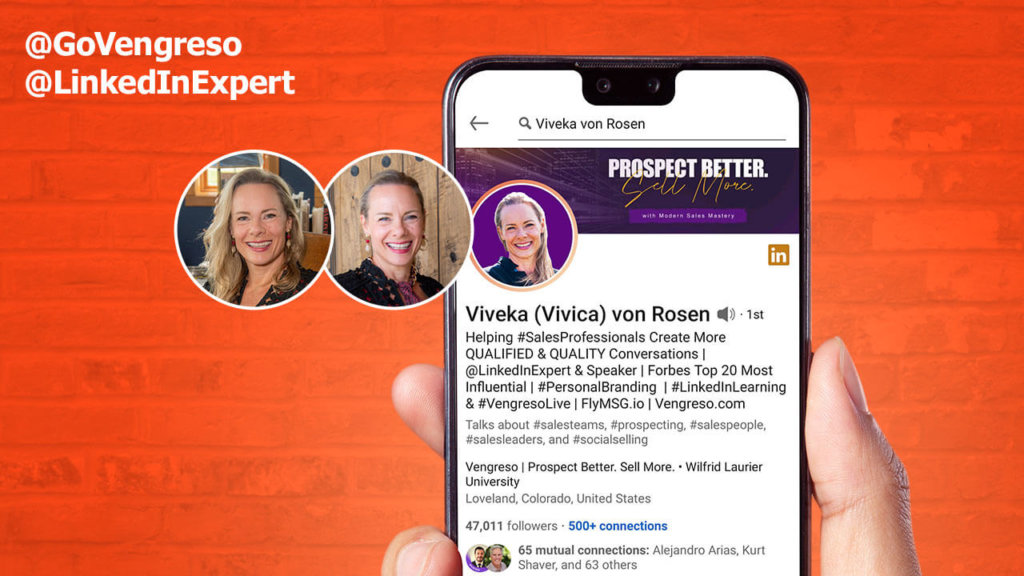TheUltimate Guide to LinkedIn® Profiles
Creating a Personal Brand For Sales Professionals
Your LinkedIn profile is a great way to make a professional first impression with a prospective buyer. Unless it’s written through the eyes of your buyer, you may not get their attention. Your profile can make or break your professional brand, and it can impact your ability to produce sales conversations with qualified buyers.
Here at Vengreso, we are professional LinkedIn profile optimization experts for sales teams and individuals. We don’t just simply change a few words, tweak a LinkedIn profile picture or edit your summary page.
We take sales professionals’ LinkedIn profiles through a process of transformation.
One where your profile is no longer seen as an online job resume, but a professional resource for your prospects. We’re sure you’re awesome – but if you’re in sales, are an entrepreneur or knowledge worker, that’s not what a profile is for.
And we can help you increase your visibility and credibility by doing LinkedIn profile makeovers for you.
If you want to be found, earn trust and get contacted on LinkedIn, you MUST make it crystal clear to your buyer that you understand and can solve their problems. Your profile is a great place to do that.
Our guide aims to share with you the most effective practices and proven techniques we have developed. These strategies have greatly benefitted more than 5,000 sales professionals, executives, and entrepreneurs in generating a higher number of sales conversations. That’s the whole point, right? You can’t sell more if you’re not having conversations with qualified prospective buyers.
We want you to know how to make the most of your LinkedIn account, since that is foundational to social selling success. LinkedIn is the leading B2B professional networking platform to grow your network. But, what’s the point of growing your network if your profile doesn’t help you generate more sales opportunities?
We want you to be found, earn trust and get contacted, so you can have more interesting sales conversations.
We are experts at this. We’ve done it for our own profiles – we walk the walk – and now we want to show YOU how an optimized profile can be created to help you take your sales potential to the next level.
Your LinkedIn Profile Should Have These Basic Elements for it to Work for Your as a Sales Asset
- Your professional profile photo should be an up-to-date picture, preferably a headshot, where you wear a smile that radiates positivity and compels others to connect with you.
- A LinkedIn Header Image that's on brand and clearly communicates where you work.
- Content such as video, audio, presentations, PDF case studies, etc., helps you stand out and allows your buyers to learn how you can help them.
- A LinkedIn About or Summary serves as a narrative about how you help your buyer and gives some insight into you as a person.
Transform your LinkedIn profile from a self-centered resume to a valuable resource for potential buyers. By focusing on their needs and concerns, you’ll attract more visitors and boost the likelihood of initiating sales conversations.
More Conversations = More Pipeline
But there are so many more ways to transform and ensure your profile stands out and is a great tool for you! And we’re here to tell you all about it!
To attract potential customers, establish a consistent flow of opportunities, and dramatically increase your sales, it is absolutely imperative that you fully harness the power of LinkedIn.
By doing this, you can have more meaningful sales conversations with interested buyers.
LinkedIn may provide the canvas, but we provide the best LinkedIn profile tips, and know-how based on our experience transforming thousands of profiles. We want to help you with how to build and manage a profile that attracts people and has them lining up to meet you.
You attract buyers by positioning yourself as a resource (you will hear us say that a lot) who can help them solve their unique problems.
How you craft your profile with content written through the lens of your buyer – along with how you engage with people – makes them want to get to know you. A professional LinkedIn profile will help to position you as someone of value who can help your buyer.
The content you post on LinkedIn can help you get found by your buyers, invite their engagement and stimulate conversation with you.
By consistently sharing relevant content and actively engaging with potential clients by sending connection requests, sharing articles, and joining conversations, you increase your chances of being discovered and contacted by buyers.
The more effort you put into building your online presence, the more opportunities you create for yourself online.
And it brings people to your profile… So, here’s what you need to know about how to make a good profile.
1. Resource Not Resume
Instead of writing a professional profile through the lens of the buyer, many salespeople write a resume to summarize their job or career, boast about exceeding their quota and how they are a strong contract negotiators – offering absolutely no value to their buyer. Your buyer doesn’t care about any of that stuff!!!
That’s “me-centric,” whereas we want you to be “buyer-centric.”
A potential client doesn’t want to work with you because you hit quota for the past 5 years and won a President’s Club trip to Hawaii. They will want to work with you because you can solve their problem and help them make more money, or save costs, or complete a project, or look good to their boss. The key is showing that you know what your buyer wants to know about how you can make their life better! Your LinkedIn profile is a great way of doing that – as long as it’s focused on your buyer.
At Vengreso we say – “transform your LinkedIn profile from a resume to a resource for your buyer.”
We say this because your buyer cares about themselves and what you can do for them, not your shiny new BMW.
 If you are a quota-carrying salesperson, you will create more sales conversations with qualified buyers by attraction rather than promotion. Your LinkedIn profile should be about HOW you help your customer – not a resume of what you’ve accomplished.
If you are a quota-carrying salesperson, you will create more sales conversations with qualified buyers by attraction rather than promotion. Your LinkedIn profile should be about HOW you help your customer – not a resume of what you’ve accomplished.In sales, focus on being a helpful resource instead of boasting about yourself. Show people how you can solve their problems in a cost-effective way. See the difference?!
And as you start to transform your profile, make sure your LinkedIn profile settings are set correctly.
2. Say Cheese! - Have a Great Headshot Photo
It all starts with a smile.
For your picture, you will want to have a professional headshot. No, selfies won’t cut it. That picture you took at the neighborhood barbecue probably won’t work either.
Your image needs to be audience-appropriate, and it needs to be a recent photo! Make sure it resembles you in this century. When you meet someone in person, your LinkedIn photo should be familiar to them.
Don’t use a logo as your headshot photo. Not only because we are talking about personal – not corporate – branding, but also because it goes against LinkedIn’s user agreement. Section 8 of LinkedIn’s User agreement states that you cannot:
“Use an image that is not your likeness or a headshot photo for your profile; Create a false identity on LinkedIn;… Misrepresent your identity, including but not limited to the use of a pseudonym.”
We cringe every time we see a profile picture that is grainy, obviously out of date, a vacation pic – or worst of all – an empty profile image. Why? Because accounts with a good photo get 11x more LinkedIn profile views and 40% more InMail responses than profiles without a profile picture.
Some LinkedIn Profile Optimization Do’s:
- Smile, with teeth showing
- Accentuate your jawline – it increases likeability
- Make eye contact with the camera
- Head to shoulders or head to waist framing
- You can also use these LinkedIn tips.
Some Don’ts:
- Don’t wear sunglasses
- No full body shots
- Avoid dark colors in background and attire
- Look away from the camera

I know we mentioned it previously, but please don’t forget to smile! A warm smile will disarm the people who view your profile and will make the people who connect with you feel more positive about becoming a part of each other’s professional network.
“Smile, and the world smiles with you….” – Stanley Gordon West
Your LinkedIn profile background banner is important too!
This is one of the easiest ways to emphasize your personal brand on LinkedIn. If you work for a company, then you can incorporate (with permission) your company’s branding… colors, fonts, logos etc. into your header or LinkedIn banner image.
3. Hook ‘em With a Good Headline
In the advertising world, the headline is all about the hook – hooking the viewer in – something that compels the reader/viewer to keep watching or reading.
Your headline is the first bit of information that a potential client will read about you, so you better make it count. Make them WANT to read on, make them want to find out more about you and how you and what you offer may be of use to them as they look to solve their problems, struggles and issues.
LinkedIn will display your name, picture and your headline on most of your communications with other LinkedIn members, so invest the time to make it work for you!
Most people make the mistake of writing this intro as just their “Title at Company.” They don’t take the time to describe who they are, what they do and whom they serve.
This is also a great place to make keywords count for you. Use keywords you’d like to be found for, while describing what you do and for whom.
Use LinkedIn to showcase who you are and how you help in 220 characters or less. Additionally, if you can, try to include your company name in the header as well.
Make Sure Your LinkedIn Profile Headline:
- Contains Keywords for Search Optimization
- Identifies your Target Audience (Who you help)
- Communicates Value to your Customer (How you Help)
- Displays your Company Name
- Shares your Title if there is room
220 characters may not seem like a lot to fit all that information in there, but just take a look at some examples of the best LinkedIn headlines that we transformed for our clients. It can be done! Here are two examples:
- Helping Healthcare Systems in the Southeast Reduce Supply Chain Costs | Acme Corp.
- Mitigating Cyber Attack Risks for Service Businesses in Western Canada | Acme Industries.

Your header should clearly communicate who you help, how you help them and (if it applies) where you help them geographically or the industry you serve.
Your ultimate objective is to help your potential buyer, which means you need to keep them in mind at all times.
They’re searching for solutions to their problems. When your profile provides that information, you’ll gain more attention and secure more appointments because prospects will understand who you are, what you do and how you can help them. More appointments mean more opportunities to make a sale.
4. Use LinkedIn to Tell Us Your Story - The About Page
Your About section is a crucial part of marketing your profile. You have 2600 characters to describe in detail who you are, what you do and whom you serve. If you want to have more sales conversations and really be successful, it needs to be all about your audience!
Use this space to highlight your value to the reader. It doesn’t have to be about your years in business or specific accomplishments. And while LinkedIn Profile SEO is vital, the flow of your About section, the story you tell and the insights you provide are just as or even more critical. A buyer-centric profile will build trust and credibility.
You’ll want to explain who you are, what you do, how you help, and what is your WHY? Be real, not who you think people want you to be. Clarity is key here. The clearer you tell your story through the lens of your buyer, the better they will know how you serve them and the more likely you are to convert those visitors to your profile into sales conversations.
Make sure to focus on your audience’s wants and needs. If you don’t address their pain points and show that you are a resource to them, you will not be an attractive option for them to seek your help.
LinkedIn is often used by buyers very similar to how they use Google. Buyers search for solutions. If you have the right keywords in the right places, you show up more often in a search within LinkedIn. Your summary page will want to be optimized for LinkedIn SEO, so you can be found by your prospects when they are searching.
5. Make Your English Teacher Proud
What we mean here is keep your profile copy free from spelling, punctuation and grammatical errors. Errors can create the impression of carelessness and a lack of attention to detail. If you are lazy with this, the people viewing your profile will associate it with you being a lazy or careless person.
Your buyer wants to see attention to detail; they like it because it shows you care, and that equates to you caring about them, their needs and their company. They want to know what you can do for them, and if they think you might embarrass them or make them look bad, then they will bounce to your competitor’s profile.
You want to make sure everything is written with a purpose, and that it flows. Your profile acts as a funnel, so make sure you have engaging “client-centric” copy with a natural progression to get the reader to take some form of action as they navigate your profile, whether it’s to have them send you a message, direct them to your website or landing page, make a connection request or to contact you.
A great LinkedIn profile photo leads the eyes to the headline. A great headline then flows to the summary. A well crafted, client-centric summary then naturally leads to your work experience, where your viewer will learn more about what you specifically can do to help them.
The purpose here is to make them take action. Nobody takes action from a poorly written profile that is full of errors.

You also want to speak the language of your customer – remember, you are showing how you solve
THEIR problem. Remember, your profile is not a resume of how awesome you are (and you ARE awesome, we want people to find that out for themselves when your public profile inspires them to engage with you), it is about showing how you help solve your buyer’s problems. You are a resource, a problem solver, a person of value to them.
6. Media, Please
Media that showcase your value will confirm your credibility and solidify your expertise with your buyer.
You want to make sure to add any relevant presentations, videos or recordings uploaded by URL. Avoid uploading files so that the latest version is always available on the link you’ve added to your media section. Sure, anyone can say they are the world’s best at something, but when you display examples of how you can help them, then you truly prove that you are worthy of your prospect’s attention!
You can get media to display on your profile from your marketing department or from your own experience delivering presentations. You can even include leaders at your company – the CEO, etc. – interviewed at an industry conference or on national news such as CNBC.

Your Profile Summary is the first place to showcase media, followed by your Experience Section where you can highlight media specific to that position. It helps if that content showcases how you solve problems and are a resource for your current customers and potential new clients.
Media is a major item of attraction for potential clients due to the immediate credibility it builds as well as the quick perception of value it creates.
7. Work It, Baby!
Your Experience Section can be more about you and what you do. You have 2000 characters to describe your company and your role at the company. You can list services, features and USPs (unique selling propositions) here. This is where you position what makes you and your company different from everyone else.
Make sure you link to your company’s LinkedIn page so you get their logo – otherwise that empty square next to your info sticks out and looks unprofessional. Without your company logo on display, it can create doubt in a prospect’s mind because they will wonder what kind of firm you work at that doesn’t even have a company profile on LinkedIn. If you are trying to position yourself among the major players in your industry then make sure your company has a solid presence in your experience section.
When you create a LinkedIn profile Experience Section, you will want to have:
- Present job description – Who you are, What you do and How you help
- Previous job descriptions – What you did and How you helped
- Media – You may no longer be in the position you were in when the media item came out, but it helps establish credibility and your position of authority and helps in search as well. Media examples help promote a common thread of leadership and expertise.
For every position, focus on audience wants and needs and how you were able to satisfy them. Each work example description needs to be buyer-centric and highlight how you are/were a high value resource to your customer.
8. Engagement - Not Just For Couples Anymore
A strong LinkedIn profile that’s written through the eyes of your buyer sets you up for successful engagement. In fact, you’ll be inspired to engage with others because your confidence is boosted with a strong profile that is attractive to your buyer.
Engagement on LinkedIn comes in many forms, but all with the goal of driving people to your profile in order to position yourself as a resource for them and stay top-of-mind.
Here are some forms of engagement that start online with the goal to take them offline for a sales conversation:
- Sharing relevant content creates opportunities to engage with your prospects
- Responding and commenting on posts/articles creates awareness
- Publishing posts help position you as knowledgeable in your industry
- Curating content that speaks to your audience is helpful and valuable
This engagement gives you the opportunity to connect with your prospects, and because you will have had some engagement, it will increase the chance of them accepting your connection when you send them a personalized LinkedIn connection request.

Once you’ve connected with people it’s important to have an ongoing engagement strategy that is based on adding value, not being a pitchy salesperson. DON’T be that salesperson who connects, then immediately requests an appointment to discuss your product or service. That’s a big turn-off and it can get you put in their LinkedIn penalty box. Use these proven practices to engage people on LinkedIn.
9. Compliance – Avoid the No Fun Bunch
“First, kill all the lawyers” – Billy Shakes…
Ok, don’t take us literally here, but our aim is to keep compliance off your back. Despite what William Shakespeare wrote, we know the legal team is there to keep you from getting in trouble. But life is much easier when lawyers don’t need to get involved with your LinkedIn profile.
One way to do that is to make sure you aren’t writing anything that flies in the face of your company’s communication policies, or writing anything that is false or misleading. If you list your employer as your CURRENT job, then be sure to be in compliance with their messaging and branding, because not being in compliance can be very costly. Check out everything you need to know about GDPR.
Whatever type of sales you are in, you know that you don’t want to deal with the legal team (except to help close a contract with a client). Every profile that Vengreso transforms during the LinkedIn profile optimization is in full compliance with your company’s communication policies.
Sleep well knowing that your LinkedIn profile is compliant, so you can focus on meeting more qualified buyers.
10. Complete the Funnel – Building the Pipeline
While we’ve hit the major parts of an optimal LinkedIn profile, the best LinkedIn profiles are those that are complete. Why? Because 50% of buyers avoid sales professionals with incomplete profiles. These next sections round out our list to help you attract new prospects and move them further down your sales funnel.
Education
Whether you have an MBA from a prestigious university or a degree in the “Hard Knocks of Life,” be sure to add your education to your profile. It is part of who you are. You have 2000 characters to describe what you did in school and why it’s relevant to who you are today. It can also be a point of commonality that opens the door to new connections.
Skills
Skills matter.
List them.
That is all….
Ok, for those of you not convinced, listing your keywords as skills has a twofold benefit. The more endorsements you get for those skills section, the more credible you look. Additionally, every endorsement makes your profile that much more findable under that keyword/skill.
You know best what you do and whom you serve, so you’ll have a pretty good idea of what (up to 50) skills you should add to your professional LinkedIn profile. And if you don’t add them, LinkedIn will. So, be proactive in adding the skills you want to be endorsed for.
Endorsements
Endorsements are more of a Facebook “like” than a true testimonial to how awesome you are on a topic (remember, we think you’re awesome!). But they still count.
Make sure to list your Skills and then go ahead and endorse a few of your friends and colleagues. Make sure you have the endorsement feature turned on. Here’s an article about how to get more endorsements on LinkedIn.
Recommendations
The Recommendations section of your profile has potential to be a gold mine for you. Start by writing authentic recommendations for people you’ve worked with including current and former bosses as well as customers and peers.
Reach out selectively to people you’ve worked with to request they write a recommendation for you. Ask them to highlight specific skills. Heck, you might as well draft it for them, if your relationship is strong enough. Most people appreciate that because you’re making it easier for them and if they want to help you, they’ll use your draft as a starting point.
The LinkedIn recommendation section can be indexed by Google, Bing, or Yahoo. When this happens you can be searched and found for whatever keywords are in your recommendations. This is a powerful tool for every salesperson. This is incredibly valuable, because when a buyer proactively searches for your services and reaches out to you they are 5-6 times more likely to convert. It further confirms why client testimonials and recommendations are so powerful.
Prioritize Your LinkedIn Profile – It’s Critical to Your Sales Success
We’ve laid it all out for you, we’ve opened the vault and shown you how to improve your LinkedIn profile, how to attract prospects, engage with them and make connecting with them easier. All with the goal of helping you to create more sales conversations. Here’s the thing: you can either DIY it on your own, DIY it with our help or you can let the pros at Vengreso handle it for you. We’ve helped over 5,000 sales professionals like you transform their profile into a powerful sales tool.
By now, you should be convinced that your LinkedIn profile should be a buyer-centric asset that helps you create more sales conversations. So, what’s next?
If you have a sales team of 25 or more, get in touch with info@vengreso.com to learn about LinkedIn Profile Optimization for Teams. Or, visit our Modern Sales Mastery page.
